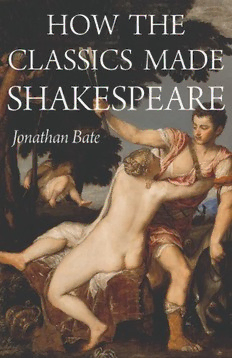
How the Classics Made Shakespeare PDF
Preview How the Classics Made Shakespeare
HOW THE CLASSICS MADE SHA•KESPEARE Also by Jonathan Bate Shakespeare and the English Romantic Imagination Shakespearean Constitutions: Politics, Theatre, Criticism 1730– 1830 Romantic Ecology: Wordsworth and the Environmental Tradition Shakespeare and Ovid The Genius of Shakespeare The Song of the Earth John Clare: A Biography Soul of the Age: A Biography of the Mind of William Shakespeare English Literature: A Very Short Introduction Shakespeare: Staging the World (with Dora Thornton) Ted Hughes: The Unauthorised Life As Editor Charles Lamb: Elia and the Last Essays of Elia The Romantics on Shakespeare The Arden Shakespeare: Titus Andronicus Shakespeare: An Illustrated Stage History (with Russell Jackson) John Clare: Selected Poems The RSC Shakespeare: Complete Works (with Eric Rasmussen) The RSC Shakespeare: Individual Works (with Eric Rasmussen, 36 volumes) The Public Value of the Humanities The RSC Shakespeare: Collaborative Plays by Shakespeare and Others (coeditor) Worcester: Portrait of an Oxford College (with Jessica Goodman) Stressed Unstressed: Classic Poems to Ease the Mind (coeditor) Introductions Titus: A Film by Julie Taymor Andrew Marvell: The Complete Poems (Penguin Classics) The Tempest: A Film by Julie Taymor The Folio Poets: Lord Byron Creative Works The Cure for Love (novel) Being Shakespeare (a one- man play for Simon Callow) The Shepherd’s Hut (poems) HOW THE CLASSICS MADE SHAKESPEARE • Jonathan Bate Princeton University Press Princeton and Oxford Copyright © 2019 by Princeton University Press This book is published as part of the E. H. Gombrich lecture series, cosponsored by the Warburg Institute and Princeton University Press. The lectures upon which this book is based were delivered in October 2013. Published by Princeton University Press 41 William Street, Princeton, New Jersey 08540 6 Oxford Street, Woodstock, Oxfordshire OX20 1TR press.princeton.edu All Rights Reserved LCCN: 2018957530 ISBN: 9780691161600 British Library Cataloging- in- Publication Data is available Editorial: Ben Tate, Hannah Paul, and Charlie Allen Production Editorial: Natalie Baan Text and Jacket Design: Leslie Flis Production: Erin Suydam Publicity: Jodi Price and Katie Lewis Copyeditor: Hank Southgate Jacket image: Titian, Venus and Adonis, c. 1555, oil on canvas. Courtesy of Shutterstock This book has been composed in Minion and Trajan Printed on acid- free paper. ∞ Printed in the United States of America 10 9 8 7 6 5 4 3 2 1 CO•NTENTS Preface and Acknowledgments ix Illustrations xiii 1 The Intelligence of Antiquity 1 2 O’er- Picturing Venus 21 3 Resemblance by Example 36 4 Republica Anglorum 48 5 Tragical- Comical- Historical- Pastoral 64 6 S. P. Q. L. 90 7 But What of Cicero? 106 8 Pyrrhus’s Pause 126 9 The Good Life 146 10 The Defence of Phantasms 160 11 An Infirmity Named Hereos 185 12 The Labours of Hercules 210 13 Walking Shadows 232 14 In the House of Fame 252 Appendix: The Elizabethan Virgil 277 Notes 285 Index 349 Ricardo Luckett Paulo Hartle Petro Holland ob eruditionem et amicitiam et in memoriam Francisci Kermode PREFACE & AC•KNOWLEDGMENTS This book grew from the inaugural E. H. Gombrich Lectures in the Classical Tradition that I delivered in the autumn of 2013 at the Warburg Institute of the University of London, under the title “An- cient Strength: Shakespeare and the Classical Tradition.” For the in- vitation, I would like to thank my dear friend Professor Peter Mack, who was at that time Director of the Warburg, and Al Bertrand of the European division of Princeton University Press. For comments, suggestions, and encouragement, I am grateful to the members of the Institute and others in the audience. The “wide gap of time” between those happy occasions and this long- gestated book is due to a combination of the pressure of other commitments and the realization that I had far more to say on the topic than was possible in the brief span of three lectures. Those lectures form the basis of several chapters, but to further my argu- ment I needed to incorporate both new research and additional ma- terial that was first essayed on other occasions: a Birthday Lecture given in 2010 at the Folger Shakespeare Library, Washington DC (with thanks to Gail Kern Paster), developed in a different form for the International Shakespeare Conference in Stratford- upon- Avon the same year (with thanks to Kate McLuskie); a lecture in the Bod- leian Library of the University of Oxford on the exact four hundredth anniversary of Shakespeare’s burial, which then became a Royal Irish Academy Discourse in Dublin; a segment of the British Academy Lecture at the 2016 Hay Festival; and even a few paragraphs from a Gladys Krieble Delmas Lecture delivered more than a decade ago for the Institute of English Studies at the University of London (with thanks to Warwick Gould). Some of the preliminary reflections in chapter 1 were given a trial outing in an April 2016 essay in the Guardian, “Shakespeare: Who Put Those Thoughts in His Head?” The Epicurean aspect of the Horatian argument in chapter 9 further develops “Shakespeare the Epicurean,” chapter 24 of my book Soul of the Age: A Biography of
